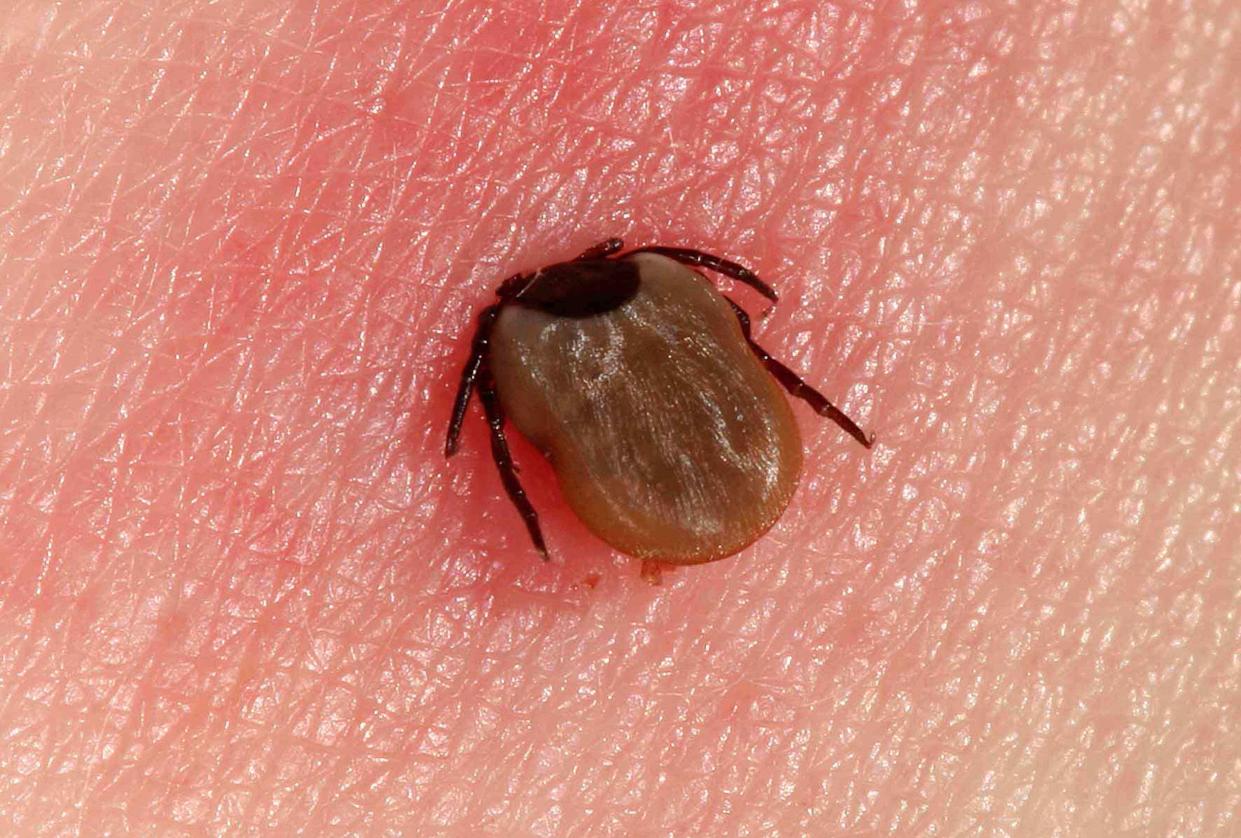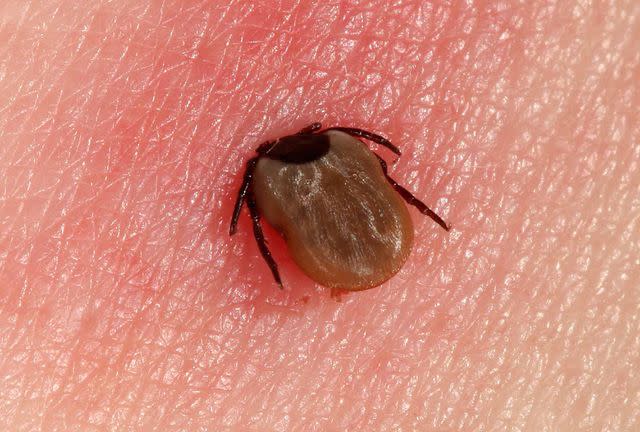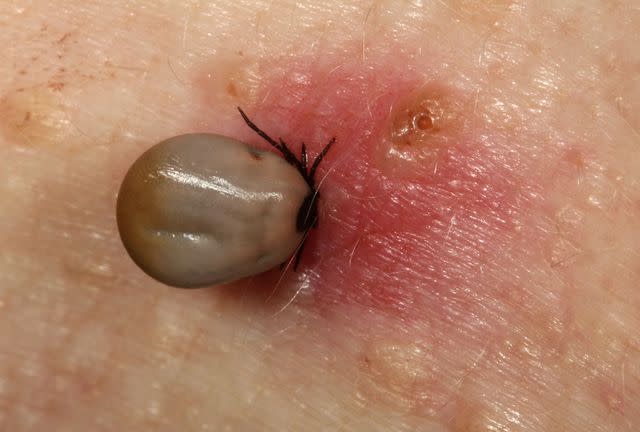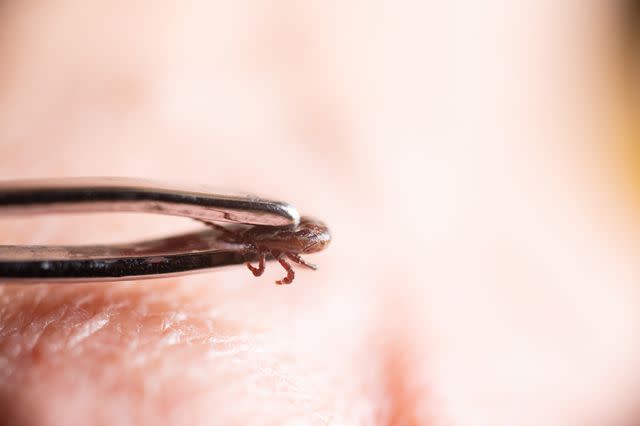Identifying a Tick Bite From Pictures

Reproduced with permission from © DermNet and © Raimo Suhonen dermnetnz.org 2023.
Medically reviewed by Susan Bard, MD
Tick bites can be common, but recognizing their characteristics and distinguishing them from other tick-borne illnesses, such as Lyme disease, is vital.
In this article, we will explore the distinct features of tick bites, including redness, inflammation, and itching, as well as the bull's-eye rash associated with Lyme disease. By understanding these characteristics, you can proactively protect your health and seek timely medical attention if needed.
Tick Bite: Pictures of Single Bite

Reproduced with permission from © DermNet and © Raimo Suhonen dermnetnz.org 2023.
Ticks are pesky insects that latch onto you while passing through bushes, plants, or grass. Once they find their way onto your body, ticks typically seek warm and moist areas. These include the armpits, groin, or hair, where they firmly attach themselves and begin feeding on your blood.
It is important to avoid ticks, as they can carry and transmit bacteria and other disease-causing organisms, posing a risk to your health.
Not everyone develops the same reaction to a tick bite, and some people may not experience any visible symptoms. It's essential to look for ticks on you after you have been in areas where ticks are common. Seek medical attention if you notice a tick or tick bite and have concerns or unusual symptoms.
Tick bites can look different among individuals but may have some of the following characteristics:
A small, raised bump on the skin
A bull's-eye rash (red ring around the bite mark)
A small, irritated, itchy spot
A tick that's visible on the skin at the site of the bite
Tick Bite: Pictures of Rash
Tick bite rashes can vary in appearance, depending on factors such as the individual's immune response and the specific illness carried by the tick. Here are descriptions of some common rash patterns associated with tick bites:

Reproduced with permission from ©DermNet dermnetnz.org 2023.
Lyme Disease Rash, or Erythema Migrans (EM) Rash
A common sign of a tick bite with Lyme disease is a distinctive bull's-eye rash known as erythema migrans. This rash is characterized by a central red spot surrounded by a clear area and an outer ring of redness.
This rash typically appears within three to 30 days after a tick bite. It often starts as a small, red bump or a solid red expanding rash that gradually forms a circular or oval-shaped pattern. The rash may have a red outer ring, a clear center, and can grow larger over time.
Southern Tick-Associated Rash Illness (STARI)
This rash is similar to the bull's-eye rash of Lyme disease but typically has a less distinctive bull's-eye pattern. It usually appears as a red, expanding rash around the site of the tick bite within a few days to a week after the bite. The rash may be circular or irregular in shape.
Spotted Fever Rashes
Tick-borne illnesses such as Rocky Mountain spotted fever can cause rashes. These rashes usually begin as small, flat, pink spots or blotches that gradually spread and merge over time. They often appear on the wrists, ankles, palms, soles, and forearms, and can sometimes become more widespread.
The appearance of the rash can vary significantly, and individuals who do not develop a rash or exhibit an unusual rash are at a higher likelihood of being diagnosed incorrectly.
It's important to note that not all tick bites result in a rash, and the absence of a rash does not necessarily mean the absence of a tick-borne illness. If you have been bitten by a tick and are concerned about potential health risks, seek medical advice for proper evaluation and guidance.
Treatment After Identifying Tick Bite From Pictures
Once a tick bite has been identified through pictures, it is important to take appropriate measures for treatment. Here are the recommended steps to follow, according to the Centers for Disease Control and Prevention (CDC):
Safely Remove the Tick
Using tweezers, grasp the tick as close to the skin's surface as possible. Gently pull upward with steady pressure, ensuring you avoid squeezing or crushing the tick. Dispose of the tick in a sealed container or by flushing it down the toilet. The tick can also be sent off for analysis to determine if it was infected with tick-borne illnesses.

Aitor Diago / Getty Images
Clean the Area
Thoroughly cleanse the bite site with soap and water to reduce the risk of infection.
Monitor for Symptoms
Keep a close eye on the area for any signs of an adverse reaction or symptoms of tick-borne illnesses. These may include fever, rash, headaches, or body aches.
Consult a Healthcare Professional
If you experience any concerning symptoms or are uncertain about the type of tick or potential risks associated with it, seek medical advice. Your healthcare provider can assess your situation, provide guidance, and recommend appropriate testing or treatment options.
Tick Paralysis in Children
Tick paralysis is caused by a toxin in a tick's saliva. It leads to gradual weakness or paralysis that moves up the body. These symptoms can be similar to other neurological conditions. Fortunately, removing the tick usually resolves symptoms within 24 hours.
Tick Bite Not Getting Better
The CDC advises you to consult your healthcare provider for guidance if you have a tick bite that is not improving.
Depending on the situation, the CDC reports that a single dose of doxycycline after a tick bite may reduce the risk of Lyme disease. It is worth discussing this option with your healthcare provider if you reside in an area where Lyme disease or other tick-borne diseases are prevalent.
Remain vigilant and monitor your health for any symptoms over 30 days after noticing the bite. It is essential to contact your healthcare provider if you experience any of the following symptoms:
Headache
Rash
Fever
Fatigue or weakness
Muscle pain, or
Joint swelling and pain
The treatment for tick-borne diseases is typically based on your symptoms, history of tick exposure (i.e. having a tick bite in the past), and, in some cases, blood test results. Most tick-borne diseases can be effectively treated with a short course of antibiotics.
Summary
Identifying a tick bite quickly is vital to minimize the risk of potential tick-borne illnesses and get timely treatment if necessary. Remember, if you have any doubts or experience unusual symptoms, don't hesitate to seek medical advice. A healthcare provider can offer essential treatment to manage potential tick-borne illnesses and their symptoms.

